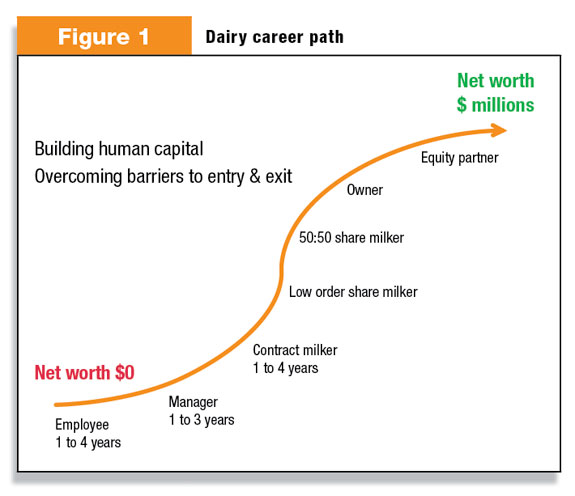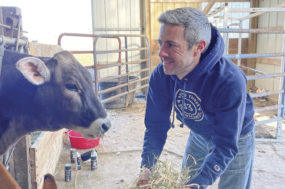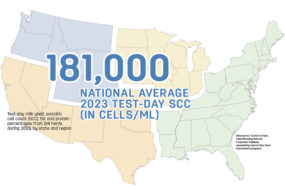In sharemilking, a farmer operates a dairy farm on behalf of the farm owner for an agreed share of income and expenses. It is a proven business model which has been, and continues to be, the backbone of the New Zealand dairy industry, and it could easily, if adopted, change the dairy industry within the U.S. Dairy farming around the world is not seen as a very “sexy” industry. The reality is, though, that the dairy industry allows motivated, career-minded people to succeed financially while still providing an excellent lifestyle and future stability for themselves and their families.
Sharemilking empowers both an aging or unmotivated dairy farm owner and a young enthusiastic career-focused individual, creating a win-win situation.
The dairy farm owner can:
• Enjoy a lifestyle away from the farm while still receiving an income and enjoying any capital growth in land
• Exit out of considered high-risk investments such as labor management, livestock and depreciating machinery
• Have capital for retirement or completing the “bucket list” that has always been only a dream
• Ensure that his asset is being well-farmed by an individual with a vested interest
• Find a possible answer to family succession problems that have plagued the rural industry
The sharemilker can:
• Have a viable business model that provides for equity growth and thus wealth creation
• Obtain a very clear career succession plan to potentially gain ultimate farm ownership
• Get a chance to build business acumen and control of his own destiny

It is the next generation that will determine the success of the industry, and logical, stepping-stone career opportunities with clear, attainable end results will help. As with any industry, we need to attract and retain young people who will offer new paradigms and attack challenges with a fresh positive approach.
A good long-term dairy incentive program will drive desire, excellence and commitment with so-called “golden handcuffs.” Sharemilking creates a system in which the employee has a vested interest in a business model and contractual commitment to see the model through. This motivates the employee to exhibit hard work, creative excellence and improved efficiency while focusing on profits.
Within the dairy industry in New Zealand, and the U.S. business model of our Missouri-based pastoral dairy company, we have implemented a business plan to encourage excellence, providing a clear, logical dairy career progression and retention of young talent. This model promotes a desire to learn and keeps individuals engaged as well as motivated. We have 12 pastoral farming dairy units, of which five are now operating in some degree of sharemilking contractual arrangement. We have observed that individuals working in our sharemilking positions have respect for their dairy farm owners and an optimistic belief that their work ethic and desire will be rewarded with equity in the future.
Sharemilking contract examples
Different scenarios of sharemilking are available, including the following, more common forms:
50:50 sharemilking contract
In this scenario, the land and infrastructure (including dairy barn and support buildings) are provided by the land owner and the sharemilker provides all necessary rolling machinery and livestock. This option requires the greatest injection of capital from the sharemilker; however, in return, the sharemilker gets a 50 percent share of the milk check. Costs are generally shared and differ on a contract-by-contract basis. The sharemilker also gets all the progeny from the livestock, which is a key factor in this model’s ability to capture wealth creation. The sharemilker grows and builds equity through the progeny livestock, which in turn can be borrowed against or sold for future cash flow.
Contract milking arrangement
This sharemilking scenario can vary, depending on what the sharemilker brings to the partnership in the form of capital. Often this arrangement results from the sharemilker’s limited start-up equity. The sharemilker’s side of the contract could be:
• Limited stock, machinery and necessary labor
• Rolling machinery and labor only
• Simply a contract where the sharemilker provides all the labor responsibilities (The share a milker would receive from the milk would represent a higher-than-average industry wage.)
In each one of these scenarios, a sharemilker would receive a different share of the milk check from the owner, from 17 percent to 30 percent. All these forms can create stepping stones to 50:50 sharemilking, which can realistically happen within two to four years.
The returns on the investment for the sharemilker can be very attractive, but are also aligned with the investment principle of “the higher the risk, the higher the return.” For the owner, the returns are attractive and without the risks of labor, machinery or livestock, while at the same time allowing a significant, passive income.
Sharemilking, or “dairy franchising,” is not a new concept, but it is still perceived as being “not the norm” and is therefore greeted with a degree of skepticism from staff and locals. It is also seen as akin to sharecropping, which struggled within the U.S. This will take time to change. Our experience, however, has been extremely successful and remains an integral part of our future U.S. business growth plans.

Take-home message
A sharemilking arrangement can be driven by many desires from an owner’s perspective – securing a highly-valuable staff member, looking at securing capital for other investments, maintaining an interest in the land but not farming anymore, or retirement planning with assistance in succession plans.
It is a true business partnership built on trust for both parties. An owner needs to have faith that his asset will be looked after and improved upon, both in respect to profit generation and capital value added to the farm itself. Other major areas for individuals interested in sharemilking to focus on include:
• Prepare – A good working contractual obligation which sets out the rules of engagement with little or no gray areas is a must.
• Search – Seek out individuals who have good work ethics and the ability to organize, plan and create a good working team environment.
• Examine – Ensure a potential sharemilker’s business acumen is sound and that he or she is profit-focused and knows the value of a dollar.
• Double-check – Confirm potential sharemilkers have business and livestock experience and are aligned with your business’s philosophies and paradigms, yet are open to be challenged by your goals.
Sharemilking is an excellent business model that motivates the two ends of the dairy spectrum – those eager to get into the business and drive wealth creation and those looking to slow down or change direction. It’s a true win-win answer. We are positive it can grow the number of dairy farms in milk deficit regions. PD
PHOTOS:TOP RIGHT: Sharemilker's home on premises at Wilson Springs Dairies, Carthage, Missouri, owned by Grasslands Consultants, LLC
MIDDLE RIGHT: University of Missouri grazing specialist Joe Horner answers questions about sharemilking at a grazing field day on Sept. 11, 2010. Courtesy photos by University of Missouri.
Tony Finch
General Manager
Grasslands Consultants LLC
tony@grasslandsllc.com






